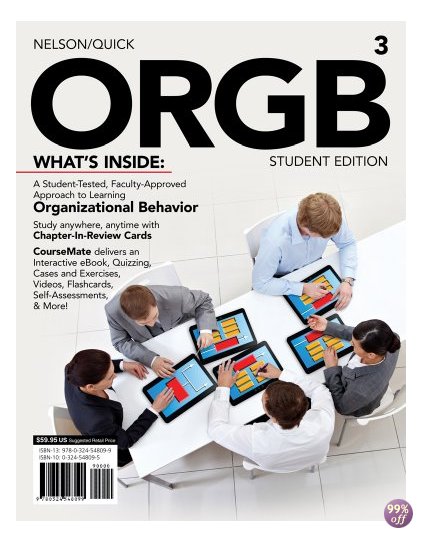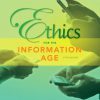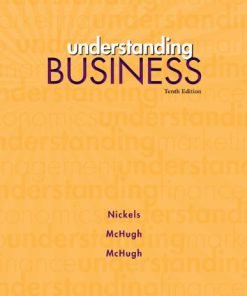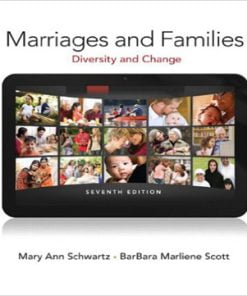Test Bank for ORGB 3rd Edition by Nelson
$55.00 Original price was: $55.00.$29.99Current price is: $29.99.
Test Bank for ORGB 3rd Edition by Nelson
This is completed downloadable of Test Bank for ORGB 3rd Edition by Nelson

Product Details:
ISBN 10: 0176873384
ISBN 13: 9780176873387
Author: Nelson, Debra; Quick, James; Armstrong, Ann; Roubecas, Chris; Condie, Joan
ORGB, Third Canadian Edition, offers comprehensive coverage of contemporary organizational behavior topics in a format that is engaging and accessible for today’s learners. Our flexible hybrid solution was developed based on feedback from both Canadian instructors and students, reflecting today’s students’ study and reading habits. The third Canadian edition includes more examples from an assortment of organizations to appeal to a wider variety of programs, including legal assistance and hospitality. The product also includes contemporary cases, examples, self-assessments, and additional activities for active learning to help make the content applied and relevant for today’s on-the-go student.
Table of Content:
- Part 01 IntroductIon
- Chapter 1 Organizational Behaviour and Opportunities
- 1-1 Human Behaviour in Organizations
- Understanding Human Behaviour
- Interdisciplinary Influences
- 1-2 Behaviour in Times of Change
- 1-3 The Organizational Context
- Organizations as Open Systems
- 1-4 The Formal and Informal Organization
- 1-5 Diversity of Organizations
- 1-6 Change Creates Opportunities
- Four Challenges for Managers Related to Change
- 1-7 Learning about Organizational Behaviour
- Objective Knowledge
- Skill Development
- Application of Knowledge and Skills
- 1-8 Design Thinking
- What about You? Learning Style Inventory
- Mini Case: Brian Cowell
- Shopify Running Case: A Canadian Success
- Chapter 2 Organizational Challenges for Today
- 2-1 Competing in the Global Economy
- Social and Political Changes
- Cultural Differences
- 2-2 Cultural Differences and Work-Related Attitudes
- Individualism/Collectivism
- Power Distance
- Uncertainty Avoidance
- Masculinity/Femininity
- Time Orientation
- Indulgence
- Developing Cross-cultural Sensitivity
- 2-3 The Diverse Workforce
- Cultural Diversity
- Gender Diversity
- LGBTQ2+ Diversity
- Age Diversity
- Ability Diversity
- Valuing Diversity
- Diversity’s Benefits and Problems
- 2-4 Ethics, Character, and Personal Integrity
- Consequential Theories of Ethics
- Rule-based Theories of Ethics
- Character Theories of Ethics
- 2-5 Ethical Dilemmas Facing the Organization Today
- Employee Rights
- Sexual Harassment
- Organizational Justice
- Whistle Blowing
- Social Responsibility
- Codes of Ethics
- 2-6 Technological Innovation and Today’s Workforce
- Alternative Work Arrangements
- Impact of Technology on Management
- Helping Employees Adjust to Technological Change
- What about You? Planning for a Global Career
- Mini Case: Jill Warner
- Shopify Running Case: Diversity in Question
- Part 02 Individuals Within Organizations
- Chapter 3 Personality and Perception
- 3-1 Individual Differences and Organizational Behaviour
- Skills and Abilities
- 3-2 Personality
- Big Five Personality Trait Model
- The Dark Triad
- HEXACO Personality Model
- Other Important Personality Traits
- Core Self-Evaluation (CSE)
- Self-Monitoring
- Positive/Negative Affect
- Situational Variables
- 3-3 Personality Assessment in Organizations
- Common Personality Assessment Tools
- The Myers-Briggs Type Indicator® Instrument
- 3-4 Social Perception
- Observation
- Attribution
- Integration and Confirmation
- 3-5 Bias and Barriers to Social Perception
- Biases in Observation
- Biases in Attribution
- Biases in Integration and Confirmation
- 3-6 Impression Management
- What about You? Are You a High or Low Self-Monitor
- Mini Case: Race Problems in Canada
- Shopify Running Case: Building the Company
- Chapter 4 Emotions, Attitudes, and Ethics
- 4-1 Emotions
- Emotional Labour
- Emotional Intelligence
- Emotional Display Rules
- Emotional Contagion
- 4-2 Attitudes
- The ABC Model
- 4-3 Attitude Formation
- Attitudes and Behaviour
- Cognitive Dissonance
- 4-4 Work Attitudes
- Job Satisfaction
- Organizational Citizenship versus Workplace Deviance
- Organizational Commitment and Job Satisfaction
- 4-5 Persuasion and Attitude Change
- Source Characteristics That Affect Persuasion
- Target Characteristics That Affect Persuasion
- Message Characteristics That Affect Persuasion
- Cognitive Routes to Persuasion
- 4-6 Ethical Behaviour
- Corporate Social Responsibility
- 4-7 Factors That Affect Ethical Behaviour
- Values
- Age and Culture in Values
- Locus of Control
- Machiavellianism
- Cognitive Moral Development
- What about You? Assess Your Job Satisfaction
- Mini Case: Doing All That Is Necessary? SNC Lavalin
- Shopify Running Case: In Support of Free Speech
- Chapter 5 Motivation
- 5-1 Motivation
- Internal Motivators and External Incentives
- Scientific Management—A Process Theory
- The Hawthorne Studies—A Needs Theory
- 5-2 Maslow’s Need Hierarchy—A Needs Theory
- Theory X and Theory Y—A Needs Theory
- ERG Theory—A Needs Theory
- 5-3 McClelland’s Need Theory—A Needs Theory
- Need for Achievement (nAch)
- Need for Power (nPow)
- Need for Affiliation (nAff)
- 5-4 Equity Theory—A Process Theory
- The Resolution of Inequity
- New Perspectives onEquity Theory: EquitySensitivity
- 5-5 Expectancy Theory—A Process Theory
- Motivational Problems
- Motivation and Moral Maturity
- 5-6 Goal-setting Theory—A Needs Theory
- Clarity
- Challenge
- Commitment
- Feedback
- Task Complexity
- 5-7 Cultural Differences in Motivation
- What’s Important to Employees
- Mini Case: Engage!
- Shopify Running Case: Employee Motivation with Spinify
- Chapter 6 Stress and Well-Being at Work
- 6-1 What Is Stress?
- Stress—A Worldwide Issue
- 6-2 Four Approaches to Stress
- The Homeostatic/Medical Approach
- The Cognitive Appraisal Approach
- The Person–Environment Fit Approach
- The Psychoanalytic Approach
- 6-3 The Stress Response
- 6-4 Sources of Work Stress
- Work Demands
- Nonwork Demands
- 6-5 Two Models Linking Stress Sources to Negative Consequences
- Job Demand-Control-Support Model
- Effort–Reward Imbalance Model
- 6-6 The Positive Consequences of Stress
- 6-7 Individual Differences in the Stress–Strain
- Self-Esteem, Self-Efficacy, and Negative Affectivity
- Type A Behaviour Pattern
- Personality Hardiness
- Self-Reliance
- 6-8 Preventive Stress Management
- Organizational Stress Prevention
- Individual Prevention
- What about You? Are You Self-Reliant?
- Mini Case: 69 Days of Stress
- Shopify Running Case: Avoiding Talent Drain
- Part 03 Interpersonal processes and Behaviour
- Chapter 7 Decision Making by Individuals and Groups
- 7-1 The Decision-making Process
- 7-2 Models and Limits of Decision Making
- Rational Model
- Bounded Rationality Model
- Vroom-Yetton-Jago Normative Decision Model
- Z Model
- Garbage Can Model
- Escalation of Commitment
- 7-3 Individual Influences on Decision Making
- Risk and the Manager
- Cognitive Styles
- Personality, Attitudes, and Values
- Intuition
- Creativity
- 7-4 The Group Decision-making Process
- Advantages and Disadvantages of Group Decision Making
- Limits of Group Decision Making
- Techniques for Group Decision Making
- Factors in Selecting the Appropriate Technique
- Special Decision-making Groups
- 7-5 Diversity and Culture in Decision Making
- 7-6 Participation in Decision Making
- The Effects of Participation
- Foundations for Participation and Empowerment
- What Level of Participation?
- What about You? Who Owns the Fish?
- Mini Case: And the Grammy Goes To …
- Shopify Running Case: Bricks, Mortar, and Green
- Chapter 8 Communication
- 8-1 Interpersonal Communication
- An Interpersonal Communication Model
- Reflective Listening
- 8-2 Barriers and Gateways to Communication
- Perceptual Filters
- Masculine vs. Feminine Communication Differences
- Cultural Diversity
- Language
- 8-3 Defensive and Nondefensive Communication
- Defensive Communication at Work
- Defensive Tactics
- Nondefensive Communication
- 8-4 Nonverbal Communication
- Kinesics
- Paralanguage
- Proxemics
- 8-5 Communicating through Technology
- Digital Natives
- Social Media
- Drawbacks of Digital Communication
- Benefits of Digital Communication
- Digital Communication at Work
- 8-6 Communication Skills for Effective Managers
- Expressiveness
- Empathy and Sensitivity
- Persuasiveness
- Informative Managing Style
- What about You? Are You an Active Listener?
- Mini Case: Smartphones: Promoting Communication Connectedness or Disconnectedness?
- Shopify Running Case: Shopify Introduces Timeline
- Chapter 9 Groups and Teams
- 9-1 Groups and Teams
- 9-2 Group Formation and Development
- Group Formation
- Diversity
- Models of Group Development
- Punctuated Equilibrium Model
- 9-3 Group Behaviour and Effectiveness
- Factors That Influence Group Behaviour
- Group Cohesion
- Factors That Influence Group Effectiveness
- 9-4 Types of Teams
- Cross-Functional Teams
- Self-Managed Teams
- Virtual Teams
- 9-5 Advantages and Disadvantages of Teams
- Advantages of Teams
- Social Benefits to Individuals
- Disadvantages of Teams
- What about You? How Cohesive Is Your Group?
- Mini Case: F1 Pit Crews Are the Epitome of Teamwork
- Shopify Running Case: Providing the Narrative for Customers
- Chapter 10 Conflict and Negotiation
- 10-1 The Nature of Conflicts in Organizations
- Functional versus Dysfunctional Conflict
- Phases of Conflict
- 10-2 Sources of Conflict in Organizations
- Task Conflict
- Process Conflict
- Relationship Conflict
- 10-3 Approaches to Conflict
- Framing the Conflict
- Conflict Management Styles
- 10-4 Conflict Management Techniques
- Superordinate Goals
- Expanding Resources
- Changing Personnel
- Changing Structure
- Improving Communication
- Negotiating
- Ineffective Conflict Management Techniques
- 10-5 Negotiation as a Conflict Management Technique
- Cultural Differences in Negotiation
- Before Negotiating
- The Zone of Potential Agreement (ZOPA)
- 10-6 Beyond Negotiating
- What about You? What Is Your Conflict-handling Style?
- Mini Case: Conflict Escalation between Neighbours
- Shopify Running Case: #DeleteShopify
- Chapter 11 Power and Political Behaviour
- 11-1 What Is Power
- 11-2 Sources and Bases of Power in Organizations
- Positional Bases of Power
- Personal Bases of Power
- 11-3 Using and Abusing Power in Organizations
- Influence Maps
- Increasing Power
- Bullying
- Sexual Harassment
- 11-4 Using Power Ethically
- 11-5 Political Behaviour in Organizations
- Dimensions of Political Behaviour
- Influence Tactics
- Political Skill
- 11-6 Managing Political Behaviour
- Sharing Power: Empowerment
- Managing Up
- What about You? How Politically Skilled Are You?
- Mini Case: Sexual Harassment in Parliament
- Shopify Running Case: Political Behaviour
- Chapter 12 Leadership
- 12-1 Leadership versus Management
- Leadership Theories
- 12-2 Trait Theories
- 12-3 Behavioural Theories
- Foundations of Behavioural Research
- The Leadership Grid®
- 12-4 Contingency Theories
- Fiedler’s Contingency Theory
- Path–Goal Theory
- Hersey-Blanchard Situational Leadership® Model
- 12-5 Transactional Theories
- Leader–Member Exchange (LMX)
- 12-6 Inspirational Leadership Theories
- 12-7 Important Concepts in Leadership
- Emotional Intelligence
- Trust
- Ethics
- Gender and Leadership
- 12-8 Followership
- Types of Followers
- 12-9 Guidelines for Leadership
- What about You? How Does Your Supervisor Lead?
- Mini Case: Dwane Casey and the Toronto Raptors
- Shopify Running Case: Growing the Brand
- Chapter 13 Organizational Culture
- 13-1 What Is Organizational Culture?
- Components of Organizational Culture
- Impact of Culture on Organizational Members
- Differentiation of Culture
- Advantages and Disadvantages of Organizational Culture
- 13-2 Levels of Organizational Culture
- Artifacts
- Shared and Espoused Values
- Assumptions
- 13-3 How Culture Is Started, Shaped, and Reinforced
- What Leaders Pay Attention
- How Leaders React to Crises
- How Leaders Behave
- How Leaders Allocate Rewards
- How Leaders Hire and Fire Individuals
- 13-4 Organizational Socialization
- The Socialization Process
- Outcomes of Socialization
- 13-5 Changing Organizational Culture
- Developing an Ethical Organizational Culture
- Developing a Culture of Empowerment and Quality
- Evaluating Organizational Change
- 13-6 The Relationship of Culture to Corporate Performance
- The Strong Culture Perspective
- The Adaptation Perspective
- What about You? Organizational Culture and Ethics
- Mini Case: The Great Little Box Company
- Shopify Running Case: Culture of Optimism and Creativity
- Chapter 14 Learning and Performance Management
- Models of Learning in Organizations
- 14-1 Classical Conditioning
- Reinforcement Theory
- 14-2 Social and Cognitive Theories of Learning
- Bandura’s Social Learning Theory
- Cognitive Theories of Learning
- 14-3 The Value of Thinking about Learning
- 14-4 Performance Management
- Defining Performance
- Goals Improve Performance Evaluation
- Measuring Performance
- 14-5 Performance Feedback
- 360-Degree Feedback
- Developing People and Enhancing Careers
- Key Characteristics of an Effective Appraisal System
- 14-6 Rewarding Performance
- Individual versus Team Reward Systems
- The Power of Earning
- 14-7 Correcting Poor Performance
- Coaching, Counselling, and Mentoring
- What about You? How Do You Correct Poor Performance?
- Mini Case: Murder–Suicide at BC Government Office
- Shopify Running Case: Continued Learning as a Path to Success
- Part 04 Organizational Processes and structures
- Chapter 15 Jobs and the Design of Work
- 15-1 Work in Organizations
- The Meaning of Work
- Jobs in Organizations
- 15-2 Traditional Approaches to Job Design
- Scientific Management
- Job Enlargement/Job Rotation
- Job Enrichment
- 15-3 Job Characteristics Theory
- Importance of Experienced Meaningfulness
- Expanding the Job Characteristics Model
- 15-4 Alternative Approaches to Job Design
- Social Information Processing
- Job Crafting and I-deals
- Job Design in the Changing World of Work
- International Perspectives on the Design of Work
- The Japanese Approach
- The German Approach
- The Scandinavian Approach
- 15-5 Contemporary Issues in the Design of Work
- Telecommuting
- Alternative Work Patterns
- Technology at Work
- Skill Development
- What about You? Diagnosing Your Job
- Mini Case: CKCK (CTV) Regina: Job Design Changes for the Newsroom Journalist
- Shopify Running Case: Flexible Work Arrangements
- Chapter 16 Organizational Design and Structure
- 16-1 Impact of Structure on Employees
- 16-2 Design Dimensions
- 16-3 Basic Structures
- Experiences with Structure
- Mechanistic and Organic Structures
- 16-4 Contextual Variables
- Size
- Technology
- Environment
- Strategy and Goals
- Interaction Between Structure and People
- 16-5 Forces Reshaping Organizations
- Life Cycles in Organizations
- Globalization
- Changes in Information-processing Technologies
- Demands on Organizational Processes
- 16-6 Emerging Organizational Structures
- Disruptive Organizational Designs
- 16-7 Consequences of a Poor Structure
- What about You? Managers of Today and the Future
- Mini Case: Great Little Box Company
- Shopify Running Case: Shopify’s Global Structure
- Chapter 17 Managing Change
- 17-1 Forces for Change in Organizations
- External Forces
- Internal Forces
- 17-2 The Scope of Change
- The Change Agent’s Role
- 17-3 Resistance to Change
- Major Reasons People Resist Change
- Managing Resistance to Change
- 17-4 Lewin’s Model for Managing Change
- 17-5 Determining the Need for Organization Development Interventions
- Diagnosis and Needs Analysis
- 17-6 Group-focused Techniques for OD Intervention
- Survey Feedback
- Management by Objectives
- Product and Service Quality Programs
- Team Building
- Process Consultation
- 17-7 Individual-focused Techniques for OD Intervention
- Skills Training
- Leadership Training and Development
- Executive Coaching
- Job Redesign
- Health Promotion Programs
- Career Planning
- Are Organization Development Efforts Effective?
- What about You? Applying the Force-Field Analysis Tool
- Mini Case: TD and Canada Trust
- Shopify Running Case: Disrupting the Retail Status Quo
- Chapter 18 Career Management
- 18-1 Occupational and Organizational Choice Decisions
- Preparing for the World of Work
- Occupational Choice
- Organizational Choice and Entry
- 18-2 Foundations for a Successful Career
- Becoming Your Own Career Coach
- Emotional Intelligence and Career Success
- 18-3 The Career Stage Model
- 18-4 The Establishment Stage
- Psychological Contracts
- Socialization Stress
- 18-5 The Advancement Stage
- Career Paths and Career Ladders
- Finding a Mentor
- Dual-Career Partnerships
- Work–Home Conflicts
- 18-6 The Maintenance Stage
- Sustaining Performance
- Becoming a Mentor
- 18-7 The Withdrawal Stage
- Planning for Change
- Retirement
- 18-8 Career Anchors
- 18-9 Career Resources
- What about You? Assess Your Flexibility Skills
- Mini Case: My Friend Morgan
- Shopify Running Case: Dev Degree Addressing Brain Gain
- Notes
- Index
- Tear-out Chapter Review Cards
People Also Search:
orgb 3rd edition
orgb 3rd
orgb 3rd edition by nelson
orgb 3rd edition by nelson download scribd
orgb 3rd edition by nelson test bank download pdf











